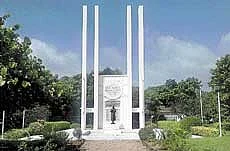

When I get off the bus in Pondicherry, the first thing that strikes me is its clean roads. Traffic is lean and disciplined. As we move towards the beach in the White Town — the French quarter is called the White Town and the Indian Quarter, the Black Town — the crackle of voices fade away. We reach our hotel, a 17th century heritage villa, located at a strolling distance from the beach. Without losing any time, we hit the streets. Exploring the town is easy, thanks to the Dutch for their good town planning. They planned the town before the arrival of the French. The design of the White Town was based on grid patterns with a geometric layout. Rectangular blocks of houses are separated by straight streets intersecting at right angles.
After a quick bite, we head to Sri Aurobindo Ashram on the Marine Street-Manakula Vinayagar Kovil Street intersection. At the tranquil entrance of the ashram, I find the source of calmness that envelopes the town. Silence follows us naturally. Beneath the frangipani tree rests the tomb of Aurobindo and the Mother. Visitors offer flowers at the tomb and meditate in the courtyard. The scent of flowers, mingled with the fragrance of incense sticks, wafts through the air. We take in the serenity and unfold our minds.
Surprisingly, the French connection of this town continues to this day. Apart from the oval-shaped city, the boulevard, the right–angled streets and 18th century architecture, the colonial influence can be seen on the hats of policemen too.
Almost all the streets are named in French — Rue Francois Martin, Rue Romain Rolland, Rue Dumas, and so on. Buildings are aesthetically coated with subtle colours and bougainvillea adorns many gates. Even the French consulate, Lycee Francois (French High School), Foyer du Soldat (a legion hall for the soldiers) and the French Institute bear the same pattern.
The peaceful and neat Bharathi Park, named after Tamil poet Subramanya Bharathi, is located in the centre of the town. It is believed that some of Bharathi’s finest patriotic compositions took shape here. In the centre of the park is Aayimandapam (built in Greco-Roman style), the most familiar monument of Pondicherry. As we walk past the Notre Dame des Anges Church on Rue Dumas, the statue of a triumphant Joan of Arc catches my attention. Images of Milla Jovovich in the movie The Messenger: The Story of Joan of Arc rush through my mind.
We take a leisurely stroll on the promenade paved with granite. The sands of the beach once hosted the fierce Anglo-French war. Now, dark big boulders harbouring emerald green algae line the shore. The 19th century light house gazing into the deep blue hasn’t lost its elegance, though it doesn’t guide the sailors anymore. A blue gate confronts you at the French war memorial on Goubert Avenue. The statue of a gloomy soldier in a bowing posture, with both his hands resting on the gun, says it all. On the day of our visit, Foyer du Soldat was reopened. It was decked up with flowers and the national flags of India and France.
Standing tall at the south end of the promenade is the statue of Joseph Francois Dupleix, who served as the French governor of Pondicherry during the 18th century and fought battles against the British.
After a tiring walk, we settle down at Le Café overlooking the Bay of Bengal. A damsel next to our table places an order for masala tea. A voice in English with a tinge of French asks for black coffee. After all, Pondicherry is a confluence of cultures.
